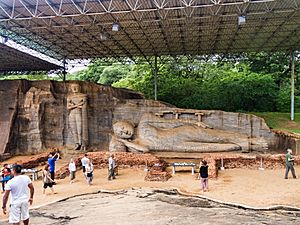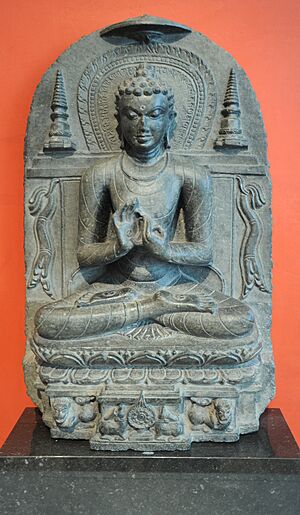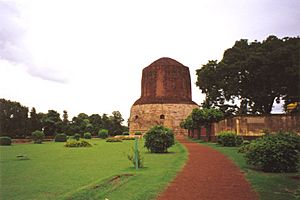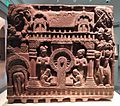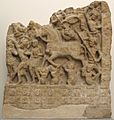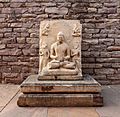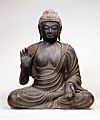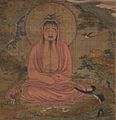Gautama Buddha facts for kids
Gautama Buddha, whose real name was Siddhartha Gautama, started Buddhism. He lived in ancient India, in a place called Lumbini. This area is now part of Nepal. He was born around 563 BC. Most people know him as the Buddha, which means "the Awakened One."
Contents
Who Was Siddhartha Gautama?
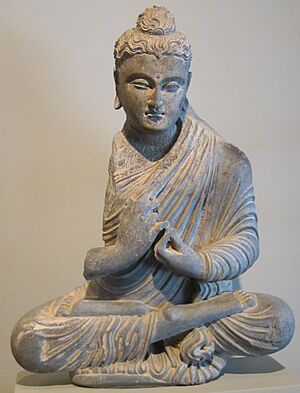
Siddhartha Gautama was not born the Buddha. He was born a prince. His father, King Suddhodana, ruled a rich and powerful kingdom.
Siddhartha grew up in great luxury. He lived in a beautiful palace. Servants took care of his every need. His father wanted to protect him. So, Siddhartha never saw suffering, sickness, or death. He enjoyed music, dancing, and many pleasures.
Siddhartha's Big Discovery
But Siddhartha was a curious prince. One day, he asked to see the world outside the palace. His charioteer took him on a different route.
Outside, he saw things he had never seen. First, he saw an old man, weak and bent. Then, he saw a very sick person. Next, he saw a dead body. Finally, he saw a holy man. This man had given up everything to live a simple, spiritual life.
These four sights changed Siddhartha's view of the world. He realized that life is not just pleasure. It also includes suffering, old age, and death. This made him very sad. He knew he had to find answers. He wanted to understand suffering and how to overcome it.
The Great Renunciation
When he was 29, Siddhartha made a big decision. He secretly left his palace, his family, and his comfortable life. He wanted to find answers about life and suffering. He cut his hair and wore simple robes. He began a spiritual journey. This event is called the "Great Renunciation."
Siddhartha spent many years looking for enlightenment. He tried different types of meditation. He studied with many teachers. He learned various spiritual practices. But none of them gave him the answers he needed.
Becoming the Buddha
After many years, Siddhartha sat under a Bodhi tree. This is a type of fig tree. He decided to meditate until he found the truth. He meditated for 49 days. He stayed completely focused. He refused to move until he found the solution to suffering. He faced many challenges and temptations.
Finally, Siddhartha achieved enlightenment. He understood why people suffer. He also found the way to be free from suffering. This moment changed him into the Buddha. "Buddha" means "the awakened one."
After becoming the Buddha, he spent his life sharing his teachings. He traveled all over India. He gathered followers and started a group of monks. He taught people from all backgrounds. His teachings spread quickly. Buddhism became a major religion.
The Buddha taught for about 45 years. He passed away peacefully at age 80. His death is not seen as an end. It is a step into Nirvana. Nirvana is a state of freedom from suffering.
What Did the Buddha Teach?
The Buddha's teachings are known as Buddhism. Buddhism is mostly about ending inner pain. Gautama Buddha taught that pain is part of life. He said pain comes from wanting things. He showed a way to end wanting and pain. This is done by doing good, avoiding bad, and training your mind. This helps people find enlightenment.
Buddhism teaches non-harm and balance. It means not going too far one way or the other. The Buddha taught people to meditate. This means thinking deeply. They often sit in the lotus position. Some Buddhists chant and meditate while walking. They do these things to understand their minds. They also do them to understand the world. Sometimes, they just want to find peace.
The Buddha did not say if gods exist. He taught that people should not rely on gods to save them. He believed it is up to each person to become enlightened.
The Four Noble Truths
The Buddha's most important teachings are the Four Noble Truths.
- Life includes suffering.
- We suffer because we want things to be a certain way.
- We can end suffering by letting go of these desires.
- The way to end desire is to follow the Noble Eightfold Path. These practices help us change our minds.
The Noble Eightfold Path
The Buddha told people to follow the Noble Eightfold Path. This path helps them understand the Four Noble Truths. These are:
- Right View: Understand the Four Noble Truths.
- Right Thought: Turn your mind towards spiritual wisdom.
- Right Speech: Tell the truth. Do not gossip or speak badly of others.
- Right Conduct: Do not do bad things like killing or stealing.
- Right Livelihood: Earn money in a way that harms no one.
- Right Effort: Work to make your mind good and less evil.
- Right Mindfulness: Always remember and use the teachings.
- Right Meditation: Practice meditation to understand reality.
The Five Precepts
Buddhists try to follow five important guidelines:
- I will not hurt any living person or animal.
- I will not take things that are not given to me.
- I will not engage in sexual misconduct.
- I will not lie or say hurtful things.
- I will not use things that make me lose control.
Monks and nuns follow even more rules.
Understanding Samsara
In Buddhism, "suffering" (dukkha) is part of a cycle. This cycle is called Samsara. It is a cycle of living and rebirth. Dukkha means feeling "unsatisfied" or "uneasy." This happens when people expect lasting happiness from things that do not last. The main goal is to find vimutti (freedom) from this cycle.
Samsara is shaped by karma. Karma is like a natural law. It is similar to how certain seeds grow into certain plants. The Buddha taught that karma is mostly about our intentions. It is not just about physical actions. Richard Gombrich says the Buddha believed: "all thoughts, words, and deeds get their moral value from the intention behind them."
Dependent Origination
The Buddha explained suffering through "dependent origination." This teaching says that everything happens because of other things. It means things only appear when certain conditions are met. Their existence "depends" on other things.
What is Anatta?
The Buddha's idea of dependent origination was a "Middle Way." It was between believing something lasts forever and believing we completely disappear when we die. He taught that people are just a series of changing parts. These parts are anatta, meaning they have no lasting self. The Buddha believed everything we experience is temporary. There is no unchanging part of a person. Richard Gombrich says the Buddha's view is simply that "everything is a process."
The Path to Freedom
The Buddha taught a path (marga) to freedom (vimutti). This path helps undo negative states of mind. The Buddha called this path a "Middle Way." It is between living only for pleasure and harming one's body.
Bhāvanā means growing good states of mind. This is key to the Buddha's path. Common practices include sila (being ethical). It also includes controlling the senses. sati (mindfulness) and sampajañña (clear awareness) are also important. Practicing dhyana helps develop good states. This leads to a state of perfect peace and awareness.
Living a Simple Life
The Buddha taught that living as a homeless, celibate "sramana" (holy person) was ideal. He said these "beggars" (bhikkhus) should give up all belongings. They should only own a begging bowl and three robes. They relied on the community for food, clothing, and shelter.
The Buddha's rules for monks and nuns are in the Vinaya collections. Monks and nuns begged for food. They could not store food or eat after noon. They were not allowed to use gold, silver, or other valuables.
Happiness in Everyday Life
The Buddha also taught about happiness in this life. He said four things lead to this happiness: "Hard work, protection, good friends, and balanced living." He also taught how to improve family relationships. He stressed the importance of love for parents and spouses.
Buddha's Lasting Impact
The Buddha's teachings still inspire millions. Buddhism teaches compassion, mindfulness, and living without suffering. The ideas of the Eightfold Path are still helpful today. They offer a guide for living ethically and finding inner peace. His legacy continues to help people find meaning in their lives, even centuries later.
Related pages
Images for kids
-
Seated Buddha from Tapa Shotor monastery in Hadda, Afghanistan, 2nd century CE
-
Inscription "The illumination of the Blessed Sakamuni" (Brahmi script: 𑀪𑀕𑀯𑀢𑁄 𑀲𑀓𑀫𑀼𑀦𑀺𑀦𑁄 𑀩𑁄𑀥𑁄, Bhagavato Sakamunino Bodho) on a relief showing the "empty" Illumination Throne of the Buddha in the early Mahabodhi Temple at Bodh Gaya. Bharhut, c. 100 BCE.
-
One of the earliest anthropomorphic representations of the Buddha, here surrounded by Brahma (left) and Śakra (right). Bimaran Casket, mid-1st century CE, British Museum.
-
The "Great Departure" of Siddhartha Gautama, surrounded by a halo, he is accompanied by numerous guards and devata who have come to pay homage; Gandhara, Kushan period
-
The gilded "Emaciated Buddha statue" in Wat Suthat in Bangkok representing the stage of his asceticism
-
The Mahabodhi Tree at the Sri Mahabodhi Temple in Bodh Gaya
-
The Enlightenment Throne of the Buddha at Bodh Gaya, as recreated by Emperor Ashoka in the 3rd century BCE.
-
The remains of a section of Jetavana Monastery, just outside of ancient Savatthi, in Uttar Pradesh.
-
Ajatashatru worships the Buddha, relief from the Bharhut Stupa at the Indian Museum, Kolkata
-
This East Javanese relief depicts the Buddha in his final days, and Ānanda, his chief attendant.
-
Mahaparinibbana scene, from the Ajanta caves
-
Piprahwa vase with relics of the Buddha. The inscription reads: ...salilanidhane Budhasa Bhagavate... (Brahmi script: ...𑀲𑀮𑀺𑀮𑀦𑀺𑀥𑀸𑀦𑁂 𑀩𑀼𑀥𑀲 𑀪𑀕𑀯𑀢𑁂...) "Relics of the Buddha Lord".
-
The Bodhisattva meets with Alara Kalama, Borobudur relief.
-
Buddha meets a Brahmin, at the Indian Museum, Kolkata
-
The Buddha on a coin of Kushan ruler Kanishka I, c. 130 CE.
-
Buddha Preaching in Tushita Heaven. Amaravati, Satavahana period, 2d century CE. Indian Museum, Calcutta.
-
Birth of the Buddha, Kushan dynasty, late 2nd to early 3rd century CE.
-
Buddha at Cave No. 6, Ajanta Caves.
-
Chinese Stele with Sakyamuni and Bodhisattvas, Wei period, 536 CE.
-
The Shakyamuni Daibutsu Bronze, c. 609, Nara, Japan.
-
Amaravati style Buddha of Srivijaya period, Palembang, Indonesia, 7th century.
-
Seated Buddha Vairocana flanked by Avalokiteshvara and Vajrapani of Mendut temple, Central Java, Indonesia, early 9th century.
-
Buddha in the exposed stupa of Borobudur mandala, Central Java, Indonesia, c. 825.
-
Vairocana Buddha of Srivijaya style, Southern Thailand, 9th century.
-
Seated Buddha, Japan, Heian period, 9th-10th century.
-
15th century Sukhothai Buddha.
-
Burmese style Buddha, Shwedagon pagoda, Yangon.
See also
 In Spanish: Buda Gautama para niños
In Spanish: Buda Gautama para niños



